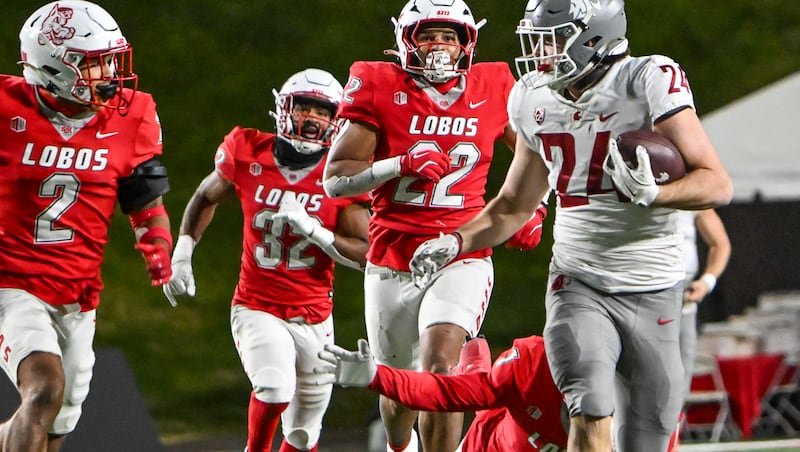
When the Utah State Aggies take the field at Maverik Stadium on August 30, many of them will be experiencing Utah State football for the first time.
A select group of Aggies will not be experiencing it for first time ever, exactly, but no longer will they be the opposition. Included in that group are six transfers — Bobby Arnold, Noah Avinger, Hyrum Hatch, Javen Jacobs, D’Angelo Mayes and Bryson Taylor — from New Mexico, players who followed Bronco Mendenhall and his staff to Utah State this past winter.
Advertisement
It isn’t abnormal for players to follow their coaches, particularly in the current NIL and transfer portal era of college football. A year ago multiple former New Mexico State players followed then-USU defensive coordinator Nate Dreiling to Utah State, and when Blake Anderson took over the job in 2020, a good chunk of former Arkansas State players followed him westward.
Even before that, when Gary Andersen took the head coaching job for a second time, leaving behind a role at the University of Utah, a chunk of Utes made the trip up 1-15 and through Sardine Canyon on a permanent basis.
Mendenhall has a unique reputation among college football coaches, though. He is demanding, has extremely high expectations and his NIL system requires players to earn everything they get, so for half a dozen players to follow him — more when you consider the former New Mexico commits who switched to Utah State ahead of the early signing period last winter — is notable.
Why follow Mendenhall to Utah State? What is it about him that appealed so much?
Advertisement
For Avinger, who had previously transferred from San Diego State to New Mexico, the allure was simple.
Washington State’s quarterback John Mateer, right, stiff arms New Mexico’s Noah Avinger as he runs down the sidelines for a gain during an NCAA college football game Saturday Nov. 16, 2024, in Albuquerque, N.M. | Roberto E. Rosales
“You’re not going to get a better leader, just on and off the field, like just a man in general (than Mendenhall),” Avinger said. “The way he kind of gives us tips on life and gives us tips on the football field and the culture that he has like within his coaching staff and that he instills in us on the team, you’re not going to find this in college football.
“I would say there’s no better leader out there, and that’s why I truly came over here and followed him.”
It is fairly safe to say that all of the New Mexico transfers to Utah State view Mendenhall in a similar light, along with his coaching staff, most of whom were also with him at New Mexico last season.
Advertisement
Jacobs, Mendenhall explained last month, is at the top of the pecking order on the team because of his buy-in.
“Our developmental system is tiered by colors, much like the martial arts,” Mendenhall explained. “And Javen is qualified for level black, which is the highest level. Most players that reach that level go on to the NFL (because of) their work ethic, their commitment, their skill set, but also their leadership.”
For Mendenhall, the benefits of adding players who’ve previously played for him are tangible, particularly this season when he is trying to turn around a mediocre USU program in a hurry by adding 70 new players to the roster.
For one, the Aggies had glaring holes at the positions now filled by Lobo transfers — at running back with Jacobs and in the secondary with Arnold, Avinger, Mayes and Taylor. Those holes have now been filled by players who Mendenhall and his staff know and know well.
Advertisement
Beyond that though, having players who’ve previously played for him, who know how things work and what things are supposed to look like in a Mendenhall-led program gives other players something to aspire to, a roadmap to work with. In theory, that helps encourage faster, more effective progress for the program as a whole.
“Let’s say they’re the highest performers currently, and our team is watching them,” Mendenhall said. “(They’ll think) ‘Oh, that’s what that’s supposed to look like.’ It’s just day after day after day, there’s momentum generated because they — the players — can see what it looks like. ‘It looks like that guy.’”
Being able to see what it looks like when players buy in to his approach helps everything move faster, which is vital since Utah State replaced two thirds of its roster.
“There’s a credibility that’s generated through the models that they see,” Mendenhall said. “That is really important for speed, because in today’s world with that many roster changes, the expectation is still to have success.
Advertisement
“It (player models) accelerates the speed, but if anything else it creates alignment and a motive to where they’re not wondering if it’s going to work. They’re all seeing that this works, not only in the individual and who they’re becoming, but quite frankly usually the number of wins at an institution.”

Arizona wide receiver Tetairoa McMillan (4) tries to break a tackle from New Mexico cornerback Bobby Arnold III (0) during the first half of an NCAA college football game Saturday, Aug. 31, 2024, in Tucson, Ariz. | Darryl Webb
